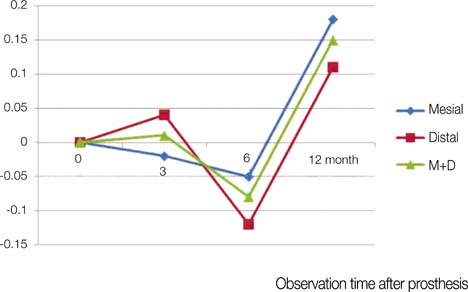J Adv Prosthodont.
2010 Jun;2(2):54-57. 10.4047/jap.2010.2.2.54.
Use of separate single-tooth implant restorations to replace two or more consecutive posterior teeth: a prospective cohort study for up to 1 year
- Affiliations
-
- 1Department of Prosthodontics, Section of Dentistry, Seoul National University Bundang Hospital, Sungnam, Gyeonggi, Korea.
- 2Department of Oral and Maxillofacial Surgery, Section of Dentistry, Seoul National University Bundang Hospital, Sungnam, Gyeonggi, Korea.
- 3Department of Prosthodontics, School of Dentistry, Seoul National University, Seoul, Korea. jhoyang@snu.ac.kr
- KMID: 1456759
- DOI: http://doi.org/10.4047/jap.2010.2.2.54
Abstract
- PURPOSE
The aim of this study was to evaluate the periodontal and prosthodontic complications of multiple freestanding implants in the posterior jaws for up to 1 year of function. MATERIAL AND METHODS: Eight patients received 20 implants posterior to canines. Two or more implants were consecutively inserted to each patient. Single crowns were delivered onto the implants. Marginal bone loss, implant mobility, probing depth, and screw loosening were examined to evaluate the clinical success of such restorations for maximum 1 year of functional loading.
RESULTS
All the implants performed well during the observation period. Neither periodontal nor prosthodontic complications were found except a slight porcelain chipping. While the marginal bone level was on average 0.09 mm lower around the implant after 6 months of loading, it was 0.15 mm higher after 1 year.
CONCLUSION
Within the limits of this investigation, separate single-tooth implant restorations to replace consecutive missing teeth may clinically function well in the posterior jaw.
Keyword
MeSH Terms
Figure
Reference
-
1. Norton MR. Multiple single-tooth implant restorations in the posterior jaws: maintenance of marginal bone levels with reference to the implant-abutment microgap. Int J Oral Maxillofac Implants. 2006. 21:777–784.2. Gotfredsen K. A 5-year prospective study of single-tooth replacements supported by the Astra Tech implant: a pilot study. Clin Implant Dent Relat Res. 2004. 6:1–8.3. Norton MR. Biologic and mechanical stability of single-tooth implants: 4- to 7-year follow-up. Clin Implant Dent Relat Res. 2001. 3:214–220.4. Wennström JL, Ekestubbe A, Gröndahl K, Karlsson S, Lindhe J. Implant-supported single-tooth restorations: a 5-year prospective study. J Clin Periodontol. 2005. 32:567–574.5. Solnit GS, Schneider RL. An alternative to splinting multiple implants: use of the ITI system. J Prosthodont. 1998. 7:114–119.6. Guichet DL, Yoshinobu D, Caputo AA. Effect of splinting and interproximal contact tightness on load transfer by implant restorations. J Prosthet Dent. 2002. 87:528–535.7. Wang TM, Leu LJ, Wang J, Lin LD. Effects of prosthesis materials and prosthesis splinting on peri-implant bone stress around implants in poor-quality bone: a numeric analysis. Int J Oral Maxillofac Implants. 2002. 17:231–237.8. Hansson S. A conical implant-abutment interface at the level of the marginal bone improves the distribution of stresses in the supporting bone. An axisymmetric finite element analysis. Clin Oral Implants Res. 2003. 14:286–293.9. Bozkaya D, Muftu S, Muftu A. Evaluation of load transfer characteristics of five different implants in compact bone at different load levels by finite elements analysis. J Prosthet Dent. 2004. 92:523–530.10. Hansson S. Implant-abutment interface: biomechanical study of flat top versus conical. Clin Implant Dent Relat Res. 2000. 2:33–41.11. Hansson S, Norton M. The relation between surface roughness and interfacial shear strength for bone-anchored implants. A mathematical model. J Biomech. 1999. 32:829–836.12. Palmer RM, Palmer PJ, Smith BJ. A 5-year prospective study of Astra single tooth implants. Clin Oral Implants Res. 2000. 11:179–182.13. Norton MR. The Astra Tech Single-Tooth Implant System: a report on 27 consecutively placed and restored implants. Int J Periodontics Restorative Dent. 1997. 17:574–583.14. Puchades-Roman L, Palmer RM, Palmer PJ, Howe LC, Ide M, Wilson RF. A clinical, radiographic, and microbiologic comparison of Astra Tech and Brånemark single tooth implants. Clin Implant Dent Relat Res. 2000. 2:78–84.15. Norton MR. Marginal bone levels at single tooth implants with a conical fixture design. The influence of surface macroand microstructure. Clin Oral Implants Res. 1998. 9:91–99.16. Palmer RM, Smith BJ, Palmer PJ, Floyd PD. A prospective study of Astra single tooth implants. Clin Oral Implants Res. 1997. 8:173–179.17. Henry PJ, Laney WR, Jemt T, Harris D, Krogh PH, Polizzi G, Zarb GA, Herrmann I. Osseointegrated implants for single-tooth replacement: a prospective 5-year multicenter study. Int J Oral Maxillofac Implants. 1996. 11:450–455.18. Hwang D, Wang HL. Medical contraindications to implant therapy: part I: absolute contraindications. Implant Dent. 2006. 15:353–360.19. Brägger U. Radiographic parameters for the evaluation of peri-implant tissues. Periodontol 2000. 1994. 4:87–97.20. Albrektsson T, Zarb G, Worthington P, Eriksson AR. The long-term efficacy of currently used dental implants: a review and proposed criteria of success. Int J Oral Maxillofac Implants. 1986. 1:11–25.21. Markiewicz MR, Raina A, Chuang SK, Margarone JE 3rd, Dodson TB. Full-mouth rehabilitation with single-tooth implant restorations. Overview and report of case. NY State Dent J. 2010. 76:36–42.22. Shin YK, Han CH, Heo SJ, Kim S, Chun HJ. Radiographic evaluation of marginal bone level around implants with different neck designs after 1 year. Int J Oral Maxillofac Implants. 2006. 21:789–794.23. Hansson S. The implant neck: smooth or provided with retention elements. A biomechanical approach. Clin Oral Implants Res. 1999. 10:394–405.24. Scherrer SS, de Rijk WG. The effect of crown length on the fracture resistance of posterior porcelain and glass-ceramic crowns. Int J Prosthodont. 1992. 5:550–557.
- Full Text Links
- Actions
-
Cited
- CITED
-
- Close
- Share
- Similar articles
-
- The level of buccal gingival margin around single and two adjacent implant restorations: a preliminary result
- 1 year follow-up study of direct and indirect composite restorations
- A retrospective study on survival rate of the most posterior single tooth implant
- Full mouth rehabilitation of a patient with tooth wear and insufficient restorative space due to loss of posterior teeth support: a case report
- Survival rates against fracture of endodontically treated posterior teeth restored with full-coverage crowns or resin composite restorations: a systematic review



